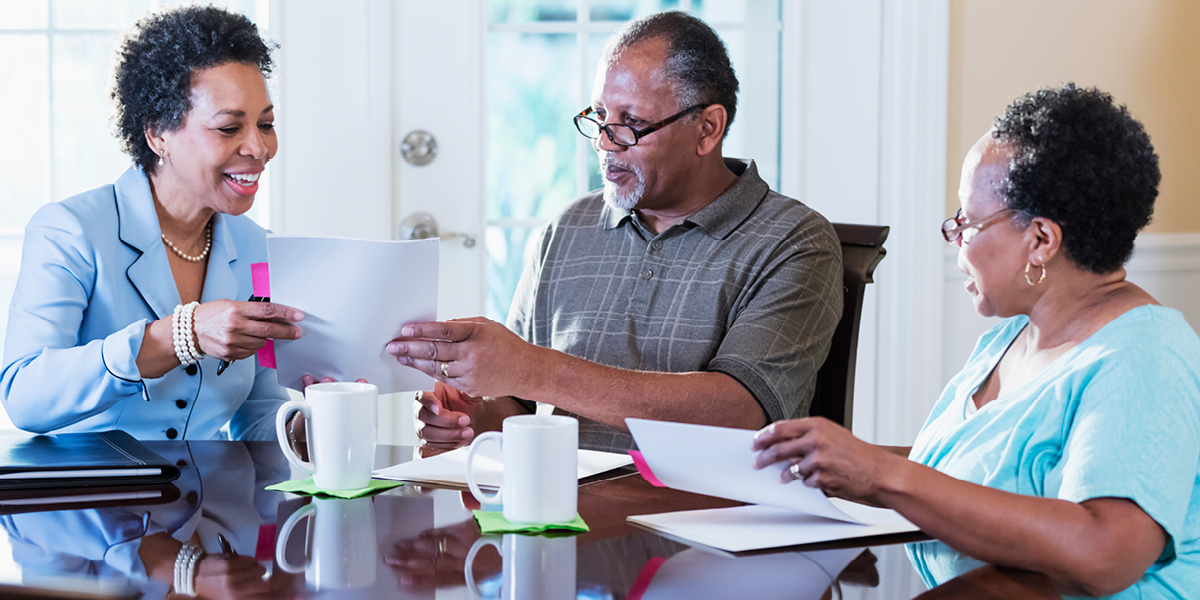Happy New Year from San Diego Foundation (SDF)!
Not surprisingly, community needs tend to rise during uncertain economic times. As 2023 gets into full swing, inflation, housing challenges and talk of a recession are pressuring people who are already vulnerable due to financial insecurity, illness or disability.
Nonprofit organizations serving these populations need additional resources — and even more support from charitable giving — to meet the escalating demands. Unfortunately, an economic downturn typically results in not more, but less, giving because many donors are dealing with fewer financial resources.
Many families have long understood that tough times are easier to navigate with the help of a solid financial plan. “Have a plan and stick with it” is often viewed as wise advice to ride out economic turbulence.
The same can be said for a planned approach to charitable giving. Now is the time for philanthropists and their advisors to be thoughtful in planning how much to give and to which organizations in 2023, and also to evaluate which tax strategies might maximize support to charities while minimizing the impact on donors’ personal financial situations.
In the spirit of the new year and the resolutions that come with it, we’re sharing tips and ideas that can help individuals, families and their advisors develop a thoughtful charitable giving plan to make the best of a tough situation.
Indeed, planning is a key theme across all areas of charitable giving, especially as you help your clients budget for their 2023 donations, adopt a year-round giving strategy, take advantage of the new “Legacy IRA” rules for QCDs or consider the increased benefits of a charitable gift annuity as interest rates rise.
As always, the SDF team is here as a sounding board.
We’re just a phone call or an email away from helping you work with your clients to map out a budget-conscious, tax-savvy charitable giving plan for 2023 that provides strong support for the local charities keeping our community afloat.
Celebrating the new Legacy IRA and a boost for QCDs
Congress passed the much-anticipated, $1.65 trillion-dollar omnibus spending bill known as the Consolidated Appropriations Act of 2023 (“CAA”) on December 23, 2022, followed by President Biden signing the Act into law on December 29, 2022. At more than 4,000 pages, the Act includes a wide range of provisions that impact multiple sectors.
Of particular interest to attorneys, accountants and wealth managers who advise philanthropists are the provisions starting midway through the bill.
The bipartisan legislation often referred to as “SECURE 2.0” is included in the CAA legislation. As background, SECURE 2.0’s provisions build on the original SECURE Act of 2019 (“SECURE” stands for “Setting Every Community Up for Retirement Enhancement). SECURE 2.0 includes the Qualified Charitable Distribution (QCD) enhancements that have been in the works for many months.
Here are three key provisions affecting philanthropists in the new law:
- Taxpayers may now make a one-time $50,000 QCD transfer to a charitable remainder trust (CRT) or other split-interest gift such as a charitable gift annuity (CGA). These are the “Legacy IRA” provisions. Note that the law effectively mandates that the CGA or CRT be created solely for the purpose of receiving a QCD because the new statute requires that the vehicle contain only IRA assets.
- The required minimum distribution (RMD) age (previously 72) increased to 73 on January 1, 2023. The age will increase to 75 beginning on January 1, 2033. While this provision is not directly tied to charitable giving, it will nonetheless impact your clients’ overall financial plans and potentially affect the timing and strategy of their philanthropy. As a reminder, “required minimum distribution” (RMD) refers to the mandated amount that a taxpayer must withdraw from qualified retirement plans, which include IRAs as well as 401(k)s and other tax-deferred retirement accounts.
- The annual per-taxpayer $100,000 QCD cap is now slated to be indexed for inflation, which will allow taxpayers to give even more from their IRAs directly to charity.
Here are three provisions that have not changed:
- Eligibility for making a QCD still starts at 70 ½. This allows taxpayers who are not yet required to take IRA distributions under the RMD rules to still take advantage of the QCD technique without the income tax hit on the distributed funds while also removing those funds from liability for future estate taxes.
- Taxpayers required to take RMDs can still count QCDs toward their RMDs, thereby avoiding the usual income tax hit on RMD dollars.
- Charities eligible to receive QCDs include designated funds, field-of-interest funds and scholarship funds at SDF, but still not donor-advised funds.
Why Charitable Gift Annuities are Having a Moment
Charitable gift annuities (CGAs) are becoming more attractive to philanthropists, making this planned giving vehicle a good fit for your clients who like the idea of an up-front tax deduction, a steady lifetime income stream and a remainder gift to charity.
If you are not already doing so, now is a good time to consider talking with clients about CGAs.
A CGA, like any other annuity, is a contract. Your client agrees to make an irrevocable transfer of cash or assets to a charitable organization. In return, the charitable organization agrees to pay the client (or a designated beneficiary such as a spouse) a fixed payment for life. Your client is eligible for an immediate income tax deduction for the present value of the future amount passing to charity.
The popularity of CGAs is increasing for three reasons:
Increase in payout rates. In late November 2022, the American Council on Gift Annuities voted to increase the rate of return assumption it uses in its suggestions for maximum payout rates for CGAs. Effective on January 1, 2023, the rate of return assumption moved from 4.50% to 5.25%.
This increase translates to a significant boost in payout rates for annuity contracts and is therefore good news for a client’s income stream. The new rates are now available on the ACGA’s website.
New Legacy IRA opportunities. With the December 2022 passage of the Legacy IRA enhancements to the QCD rules (see above), CGAs could become even more attractive. This is because the new Legacy IRA rules allow for a once-in-a-lifetime, $50,000 QCD from an IRA to a split-interest vehicle.
While the law allows a taxpayer to make a QCD to a charitable remainder trust, the $50,000 statutory maximum for a Legacy IRA gift may be a deterrent. This is because minimums for CRTs are usually at least $100,000; that is not the case, however, for CGAs, which typically can be set up at much lower minimums.
Because of the difference in minimums, the CGA may be more attractive for taxpayers who want to take advantage of the one-time Legacy IRA gift as part of a QCD strategy.
Note that CGAs created to receive a QCD contribution are different from other CGAs in a few important respects under the new law. For example, annuity payments are taxable, and must be at least 5%. Although the 5% requirement is not an issue at the moment due to the new, higher payout rates, this stipulation could present a challenge in the future.
Tax planning with appreciated assets. Gifts of appreciated assets are always a strong planning technique, especially to a CGA.
When a taxpayer contributes highly-appreciated stock in a public company, for example, to a CGA, the taxpayer typically is eligible for an income tax deduction at the stock’s fair market value on the date of the gift. When the recipient charity sells the stock, the charity pays no capital gains tax. Note that the taxpayer would have paid capital gains tax had the taxpayer sold the stock.
Especially if the stock was paying low or no dividends, the CGA has enabled the taxpayer to unlock a low-income-producing asset and convert it to a vehicle that pays an income stream. Plus, the taxpayer gets the benefit of the upfront tax deduction, presumably in a tax year where income is higher (and therefore taxed in higher brackets) than it will be when the taxpayer retires at a future date
Why Now is the Right Time to Talk to Your Clients About Charitable Giving
January is a good time to start helping your clients plan for their annual giving. With the year-end flurry of donations still fresh in many clients’ minds, you may discover that clients will welcome your suggestion to make 2023 the year to get organized early, particularly as economic headwinds make planning especially important.
A conversation that benefits everyone
Among the many benefits of discussing charitable giving with your clients is that your clients will see you as an expert on local community needs and nonprofits, especially when you have a close working relationship with the SDF team.
Your philanthropic clients want to learn how they can make a difference through their charitable activities, and they are expecting their advisors to be ready to help them structure and plan their giving.
Indeed, for years, research has shown that a proactive advisor who offers options for incorporating philanthropy into financial and estate plans inspires client loyalty, even across client generations.
Your community foundation advantage
Advisors frequently comment that they’re surprised to discover the many ways SDF can help their clients, especially compared with national donor-advised fund programs affiliated with brokerage houses or financial services firms.
Sometimes the greatest needs really are right here at home, and working with us is often the very best option for ensuring that your clients are informed and impactful philanthropists. Our team works with local nonprofits every single day and thoroughly understands how organizations are meeting community needs.
In addition, we are unparalleled in our ability to be flexible and responsive, providing outstanding, personal service designed around your clients’ needs while always respecting your role as your client’s primary advisor.
Options for every client’s unique situation
Our team welcomes the opportunity to work with you and your clients to implement their charitable giving goals. Here are just a few of the ways we can work with you as you plan for 2023:
- Wills and trusts: A client can establish a bequest to a fund at SDF through a will or trust or through a beneficiary designation on a qualified retirement plan or life insurance policy. We will provide proper bequest language.
- Retirement plan beneficiary designations: Bequests of qualified retirement plans can be extremely tax efficient. Funds flowing directly to a client’s fund at SDF from a retirement plan after the client’s death will not be subject to income tax or estate tax.
- Family philanthropy: Consider encouraging clients to involve their children and grandchildren in philanthropy, especially when the clients are working with us through a family donor-advised fund or other collaborative vehicles.
- Income tax planning: Remind clients that they are eligible for an income tax deduction for lifetime charitable gifts, and the gifted assets are no longer subject to future estate taxes.
- Complex giving: Consider more complex giving vehicles, including charitable remainder trusts, charitable gift annuities and gifts of closely-held stock. We can work with you to establish these structures to help facilitate your clients’ charitable giving goals and meet your clients’ financial and tax goals at the same time.
Learn More
For nearly 50 years, we have partnered with a large network of wealth advisors, estate planning attorneys, tax planners and other advisors to help high-net-worth clients and families achieve financial planning objectives and charitable giving goals, while maximizing tax deductions.
If you’re interested in learning how we can help meet your clients’ financial planning and charitable giving goals, contact me at (858) 245-1508 or jrogers@sdfoundation.org.






